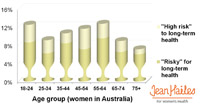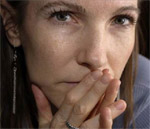Women's Life Stages and Incontinence

Women's Life Stages and Incontinence
Younger women
Up to one in four Australians over the age of 15 experience bladder or bowel control problems. Women who are particularly at risk include those who are overweight, constipated, regularly lift heavy objects, smoke or have respiratory problems such as asthma or hay fever, or have had abdominal or gynaecological surgery. Other medical conditions such as cystitis and diabetes may also affect continence.
Pregnancy
Up to 65% of women are affected by urinary incontinence during pregnancy. Women have elevated levels of the hormone relaxin, which softens the body's tissues to allow expansion as the baby grows and for the pelvic floor to stretch during birth. The combined effect of relaxin, and the pressure of the baby weight, make it harder for the muscles to hold the pelvic floor organs in their correct position and can result in stress incontinence.
This may result from the combined effect of pregnancy hormones and the pressure that affects the pelvic floor muscles by coughing, laughing, lifting or straining.
Post birth
Women who have had a natural or a caesarean birth are equally as likely to experience incontinence due to the pressure of the baby on the pelvic floor muscles during pregnancy. Also, the trauma of childbirth can cause tearing or overstretching of muscles and swelling or nerve damage that may result in incontinence. Due to post-birth pain in the perineal area, women may strain to empty the bowel, which can further weaken the pelvic floor muscles.
The body may take up to six months to recover from childbirth. Breastfeeding mothers may also have weaker pelvic floor muscles due to the continuing presence of relaxin and decreased levels of oestrogen. Some women may restrict their fluid intake for fear of incontinence which can worsen the problem as it has the effect of concentrating urine and irritating the bladder.
Menopause and the older years
The female hormone oestrogen, which decreases during menopause, has an important role in the urinary system. It helps to maintain the thickness of the lining of the tube (urethra) that runs from the bladder to outside of the body. It keeps the urethra sealed after passing urine (much like a washer seals water from leaking in a tap). As a result of this loss of oestrogen, some women experience stress incontinence during menopause.
As we age, the bladder becomes less elastic and therefore has more difficulty in stretching and can cause an -over active' bladder. An overactive bladder may result in the need to pass urine more frequently. Combined with weaker pelvic floor muscles, this makes it much more difficult to hold on or to put off going to the toilet to pass urine.
What you can do
Pelvic floor exercises are an effective way to maintain pelvic floor fitness. Good pelvic floor muscle tone assists women to maintain bladder and bowel control throughout pregnancy and helps to reduce the risk of developing a prolapse during or after pregnancy.
However, for some women with severe weakness of the pelvic floor muscles, other approaches are required to manage the condition. A referral to a pelvic floor physiotherapist or incontinent nurse can provide more specialised advice. Also, vaginal oestrogen cream or an oestrogen pessary is sometimes prescribed to help post-menopausal women.
Published with the permission of Jean Hailes for Women's Health
1800 JEAN HAILES (532 642)
jeanhailes.org.au
Have You Seen This?
MORE








